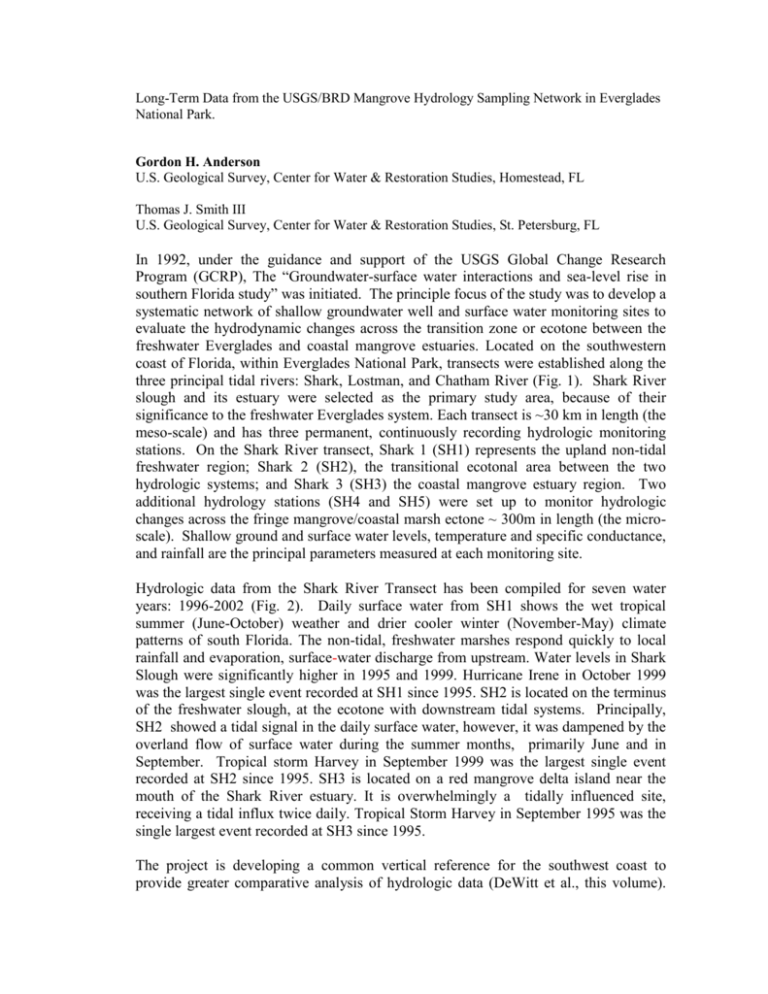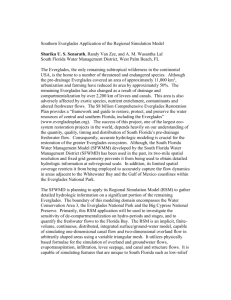Long-Term Data from the USGS/BRD Mangrove Hydrology
advertisement

Long-Term Data from the USGS/BRD Mangrove Hydrology Sampling Network in Everglades National Park. Gordon H. Anderson U.S. Geological Survey, Center for Water & Restoration Studies, Homestead, FL Thomas J. Smith III U.S. Geological Survey, Center for Water & Restoration Studies, St. Petersburg, FL In 1992, under the guidance and support of the USGS Global Change Research Program (GCRP), The “Groundwater-surface water interactions and sea-level rise in southern Florida study” was initiated. The principle focus of the study was to develop a systematic network of shallow groundwater well and surface water monitoring sites to evaluate the hydrodynamic changes across the transition zone or ecotone between the freshwater Everglades and coastal mangrove estuaries. Located on the southwestern coast of Florida, within Everglades National Park, transects were established along the three principal tidal rivers: Shark, Lostman, and Chatham River (Fig. 1). Shark River slough and its estuary were selected as the primary study area, because of their significance to the freshwater Everglades system. Each transect is ~30 km in length (the meso-scale) and has three permanent, continuously recording hydrologic monitoring stations. On the Shark River transect, Shark 1 (SH1) represents the upland non-tidal freshwater region; Shark 2 (SH2), the transitional ecotonal area between the two hydrologic systems; and Shark 3 (SH3) the coastal mangrove estuary region. Two additional hydrology stations (SH4 and SH5) were set up to monitor hydrologic changes across the fringe mangrove/coastal marsh ectone ~ 300m in length (the microscale). Shallow ground and surface water levels, temperature and specific conductance, and rainfall are the principal parameters measured at each monitoring site. Hydrologic data from the Shark River Transect has been compiled for seven water years: 1996-2002 (Fig. 2). Daily surface water from SH1 shows the wet tropical summer (June-October) weather and drier cooler winter (November-May) climate patterns of south Florida. The non-tidal, freshwater marshes respond quickly to local rainfall and evaporation, surface-water discharge from upstream. Water levels in Shark Slough were significantly higher in 1995 and 1999. Hurricane Irene in October 1999 was the largest single event recorded at SH1 since 1995. SH2 is located on the terminus of the freshwater slough, at the ecotone with downstream tidal systems. Principally, SH2 showed a tidal signal in the daily surface water, however, it was dampened by the overland flow of surface water during the summer months, primarily June and in September. Tropical storm Harvey in September 1999 was the largest single event recorded at SH2 since 1995. SH3 is located on a red mangrove delta island near the mouth of the Shark River estuary. It is overwhelmingly a tidally influenced site, receiving a tidal influx twice daily. Tropical Storm Harvey in September 1995 was the single largest event recorded at SH3 since 1995. The project is developing a common vertical reference for the southwest coast to provide greater comparative analysis of hydrologic data (DeWitt et al., this volume). The Shark River hydrologic network is centrally positioned to provide essential baseline empirical physical data needed for numerous research efforts and modeling involved with Everglades restoration. Such projects include the Tides and Inflows in the Mangroves of the Everglades (TIME) and a variety of inter-related USGS hydrological, ecological, geological and mapping investigative studies. These data provide valuable integration with South Florida National Parks resource management; the Comprehensive Everglades Restoration Plan (CERP); and the Florida Coastal Long Term Ecological Research (LTER) project. Figure 1. Locations of hydrologic sampling sites within Everglades National Park. Figure 2. Period of record for surface water stage along the main Shark River transect. Contact: Gordon H. Anderson, U.S. Geological Survey, Everglades Field Station, c/o Beard Center, Everglades National Park, 40001 State Road 9336, Homestead, FL 33034, Phone: 305-242-7891; FAX 305-242-7836; Email: gordon_anderson@usgs.gov Poster, Hydrology & Hydrological Modeling







